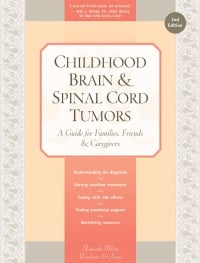Childhood Brain and Spinal Cord Tumors
Goal setting and treatment planning
A difficult but necessary step in making plans is discussing and deciding on your and your child’s goals. Health Canada’s publication, This Battle Which I Must Fight: Cancer in Canada’s Children and Teenagers, states:
This [relapse] is a time of crisis and ambivalence. The decision to be made is whether to continue to try to achieve a remission or to replace this hope with the hope for comfort for the child and a special time together. Each parent, and the child who is old enough to understand, requires differing amounts of time to reach a decision about how to proceed. Careful and frequent discussions with the medical team, as well as with trusted friends and relatives, may help clarify issues and bring some peace of mind.
In a newsletter for parents of children with cancer, Arthur Ablin, MD, (Director Emeritus of Pediatric Clinical Oncology at the University of California, San Francisco), wrote of the importance of goal setting in the decision-making process after relapse:
Before determining which treatment is to be chosen, a decision must be made to determine the goal of treatment—in other words, what is it that we are trying to achieve. This crucial first step is the basis upon which any decision concerning treatment must be made. But it is too often omitted from consideration and/or discussion, even by the most experienced. The frustrations accompanying the previous failure of treatment, the fear of the loss of the hope for cure, the pressure of urgency to find solutions, the new awareness of the possibility or probability of death, lead us all to want to consider treatments first rather than these more difficult considerations involved in establishing goals. These also force us to deal with reality earlier, which could mean the almost intolerable confrontation with the death of a very-much-loved child, a tragedy to be avoided at all costs.
If after discussion of goals your family decides to pursue aggressive treatment, there may be more than one option available. Therefore, it is important to understand the treatment avenues that are open to you. Treatment plans for a first recurrence may be specified in the standard treatment or clinical trial protocol document, or your child’s doctor may suggest a different approach. Suggestions for treatment may include surgery, radiation, stem cell transplantion, more intensive chemotherapy, a clinical trial, or a combination of several treatments.
Twenty-five days after surgery for medulloblastoma, Ayla (32 months) started chemo. Six chemo treatments were planned, but we only got through the first three, consisting of vincristine, etoposide (VP-16), cisplatin, and cyclophosphamide. They also collected stem cells for a stem cell transplant, which was never done. During this time, the MRIs showed that there was additional spread in 10 spots in the mid-brain. Chemo was stopped and the last three treatments (thiotepa and carboplatin) weren’t used. Exactly 1 day after Ayla’s third birthday, she started radiation, and got the maximum doses for cranial and spinal radiation. Ayla sailed through radiation. She didn’t get that sleepy period, although she did add an extra couple hours of nap every day. She had her radiation treatments early in the morning for 6 weeks. The whole thing took half an hour, and just a few minutes for the actual procedure. The radiation tech would give her the sedative, her special “milkshake” medicine, through her Hickman®. Afterwards, we’d go out for the day and play. Most, if not all, of the spots that they were watching are gone now and her original tumor site is showing scar tissue.
Do not rush into treatment if you or your family feel uncomfortable about the plan. There is always time to obtain answers to all of your questions and to get a second opinion. Doctors make recommendations based on knowledge, experience, and consultations with other experts in the field. Do not hesitate to ask your child’s doctor why she has suggested a certain treatment approach to your child’s relapse. Ask the doctor about treatment goals, methods, and possible side effects. Also ask if she has consulted with others in the decision-making process, and if so, with whom. Be certain older children and teens are involved in decisions regarding their care and treatment choices.
Our 18-year-old daughter was diagnosed with medulloblastoma in the cerebellum when she was 2 years old. She was treated with high-dose chemotherapy followed by stem cell transplant. At her 2 year off treatment MRI, the tumor was back—tiny and at the same site. It was again totally resected and this time we knew she needed radiation. The question was: what kind?
Table of Contents
All Guides- Introduction
- 1. Diagnosis
- 2. The Brain and Spinal Cord
- 3. Types of Tumors
- 4. Telling Your Child and Others
- 5. Choosing a Treatment
- 6. Coping with Procedures
- 7. Forming a Partnership with the Treatment Team
- 8. Hospitalization
- 9. Venous Catheters
- 10. Surgery
- 11. Chemotherapy
- 12. Common Side Effects of Chemotherapy
- 13. Radiation Therapy
- 14. Peripheral Blood Stem Cell Transplantation
- 15. Siblings
- 16. Family and Friends
- 17. Communication and Behavior
- 18. School
- 19. Sources of Support
- 20. Nutrition
- 21. Medical and Financial Record-keeping
- 22. End of Treatment and Beyond
- 23. Recurrence
- 24. Death and Bereavement
- 25. Looking Forward
- Appendix A. Blood Tests and What They Mean
- Appendix C. Books and Websites

